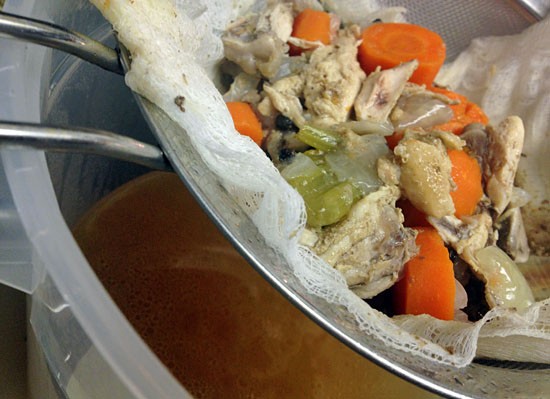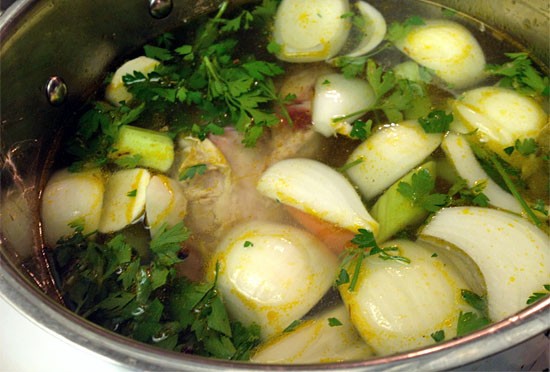
Admittedly, we're well aware the title of this blog post couldn't be more boring. But, if you're not making stock at home yet, little do you know how exhilarating the quest for perfect stock can be.
First, if you're still buying canned soup or chicken stock at the the store (and you have the time to make your own), throw it in the trash. It's processed, high in sodium and low on flavor. You'll soon find the homemade stuff is a gateway drug to discovering more delicious and nutritious things in the kitchen.
For the most part, making broth is about simmering bones with chopped up veggies for a few hours. After making liters upon liters, we thought we'd share some of the things we learned.
]
Why take the time to make it?
It's going to take several hours, but do it for these reasons: 1) Flavor. There's a reason the McRib hasn't won any BBQ competitions. Fresh is better. Homemade stock is great for soups, but it can also enhance the flavor of sauces, beans, rice and mashed potatoes to name a few. 2) Stock is a form of holistic medicine. It's true 'cause science said so. Just open that link for the nutritious details. 3) Salt. Too much is a bad thing, and almost everything in the American diet is full of sodium and sugar. Here's your chance to take back control. 4) Because your grandma probably did it. You want your food to taste old school? Then cook old school.
And, just so we're clear, here's the difference between a stock and a broth from the Culinary Institute of America: “Broths can be served as is, whereas stocks are used in the production of other dishes.”
Now let's get cooking:

For a basic stock, you'll need a chicken carcass, one onion, two celery stalks and two carrots. The easiest way to do that is to pull all the meat from a supermarket rotisserie chicken, or spatchcock your own.
You could throw it all in the pot together, bring to a boil, reduce to a simmer and call it a day, but different components require different cooking times to extract the maximum flavor, which is where a more methodical approach comes in.
The CIA breaks it down best: 1) Chicken/bones/skin/fat go in a stock pot with enough water to just cover it. Toss in a few solid pinches of salt. 2) Bring water to a simmer over medium heat, reduce the heat slightly and simmer for 3 to 5 hours (your choice), skimming the surface as necessary. 3) Add the vegetables and simmer for 30 minutes. 4) Add a sachet (scant thyme sprigs, parsley stems, bay leaves and cracked peppercorns wrapped in cheesecloth) and continue to cook for another 30 to 40 minutes. 5) Run in batches through a cheesecloth and mesh strainer to clean up the broth. It's now ready to use in another dish, or to cool it down to refrigerate or freeze. You can even reduce the stock further to intensify the flavor.
Swedish chef Magnus Nilsson, known for his forest foraging and caveman cooking style, says making stock is one of the most delicate preparations, and very easy to ruin. He's crazy and also suggests cutting down the bones very finely, to 1 centimeter cubes, to ensure maximum seepage. That's way hardcore.
However it's done, the beauty of making chicken stock is in utilizing the whole animal. If you buy the pasture raised chickens from OC Poultry & Rotisserie in Anaheim, they come with head and feet attached. Dee Nguyen at Break of Dawn brought me even further out of my Western comfort zone, suggesting throwing in the feet too, because they are rich in gelatin. Aye, aye, captain.
Variations

For an added depth of flavor, roast the vegetables and bones first. Or infuse the liquid with ginger, garlic, lemongrass, soy sauce, star anise, peppercorns, cloves, etc. for an Asian broth; jalapenos, cayenne, corriander, cumin and garlic work well as the base for tortilla soup.
You can even just toss in some fresh herbs, cooked egg noodles, thinly-sliced veggies and small strips of raw chicken. They'll cook in the liquid and it's chicken noodle for dinner.
And, for the vegetarians who had to suffer through this massacre…
Simmering mushrooms in water produces amazing things. Something we're planning on doing soon is using concentrated mushroom broth to enhance spaghetti sauce, as Roy Choi does for “$4 Spaghetti That's Almost as Good as $24 Spaghetti,” a cheaper re-do of Scott Conant's tomato-basil spaghetti. Here's how that's cooked.
Easiest of all, Thomas Keller suggests using parsley-infused water to brighten up vegetables and rice. But that's a whole different journey through the wide world of stocks.
Feel free to add your tips, variations and recipes in the comments section below!
Follow Stick a Fork In It on Twitter @ocweeklyfood or on Facebook! And don't forget to download our free Best Of App here! Follow Niyaz in the kitchen at Fat Dude On A Diet and facebook.com/thefatdudediet.

